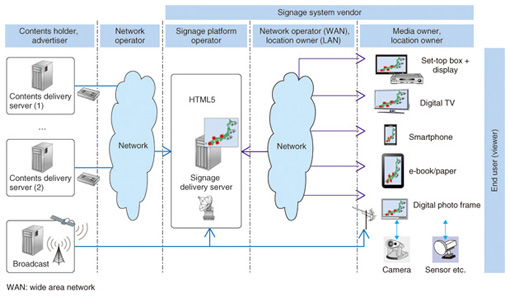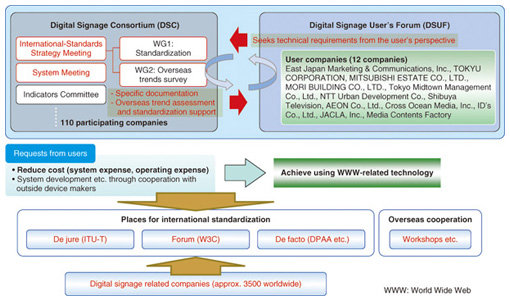 |
|||||
|
|
|||||
|
Global Standardization Activities Vol. 10, No. 10, pp. 45–50, Oct. 2012. https://doi.org/10.53829/ntr201210gls Digital Signage StandardizationAbstractIn this article, we discuss a vision for digital signage in the future and standardization activities toward this vision, which incorporates insights and know-how gained through the experience of last year's Great East Japan Earthquake. Digital signage utilizing broadband networks has already begun to spread in industrialized regions, mainly in Europe, America, and Japan, and more installations are expected in a variety of locations. For digital signage to develop further as a next-generation infrastructure for distributing information, there is a need to ensure compatibility among products from different manufacturers and interconnectivity for communications, so international standardization is becoming more important. 1. IntroductionAfter the Great East Japan Earthquake on March 11, 2011, and the power supply problems due to the ensuing nuclear power plant incident, digital signage systems were temporarily shut down to save power, and planned new installations were delayed or cancelled one after another. These measures had a major effect on the digital signage market in Japan. However, directly after the earthquake, the usual programming schedule changed, and digital signage was used as an effective tool for distributing information to people unable to return home and confined indoors, by displaying news broadcasts from NHK (Japan Broadcasting Corporation). There were many positive cases in which urban signage was used effectively to provide information helpful for daily life after the earthquake, such as disaster news and information about survivors and radiation. This led to greater recognition of the value and importance of digital signage. Most companies operating digital signage experienced new issues such as not having operation manuals that anticipate disaster and other emergency situations, no analysis of content required at specific locations during a disaster, and no preparation of such content for distribution beforehand. Taking these into consideration, the Production Department of the Digital Signage Consortium has analyzed the types of content needed when a disaster occurs, dividing the time-line following a disaster into three periods (disaster, initial recovery, and post-recovery) and defining three types of region (disaster-hit, partially damaged, and safe). It then summarized the results and proposed the following regarding content needed in times of disaster. (1) Local information, using the local characteristics of the digital signage, is essential. (2) Train and bus operation information is needed (in urban areas). (3) NHK is a useful source of information directly after a disaster. (4) Use of public advertising for televising during a disaster must be arranged beforehand. (5) Content and operation must be integrated. To provide the content needed at the time of a disaster, we need a digital signage platform for disaster response such as that shown in Fig. 1. For the implementation of such a platform, cooperation and discussion among government, academia, and the private sector is very important.
For situations such as disasters and emergencies, the NTT Group has developed the “Hikari Signage” digital signage solution, with solar signage incorporating solar panels and batteries so that information can still be provided when the power supply is unreliable. We are promoting the deployment of these systems first in highly public locations. In October, 2011, we introduced examples of using digital signage as a tool for distributing information in the aftermath of the Great East Japan Earthquake at Telecom World 2011, held in Geneva, Switzerland. The solar signage exhibits (Fig. 2) attracted much interest from government-agency-related attendees from various countries. This demonstrated a high level of awareness of the importance of providing information in public places and of using natural energy sources, and it reinforced our impression, common around the world, that addressing these issues is essential for disaster prevention.
2. Trends in digital signage systemsNext, we discuss some trends in digital signage systems. This includes the transition from dedicated systems, which have been dominant until now, to remote controlled systems utilizing networks, and the development of systems applying next-generation web technologies. These systems can be divided into three generations (Fig. 3).
- 1st generation: Dedicated systems with distribution servers and terminals provided as a set. - 2nd generation: Distribution servers located in a datacenter and systems controlled remotely over a network. - 3rd generation: Systems utilizing next-generation web technologies. First-generation systems were dominant until a few years ago, but second-generation systems have recently overtaken them, providing the benefits of improved usability, decreased installation and operating costs, and no need for dedicated operators, even for large-scale installations on tall buildings or in airports. These merits are also clearly effective for medium- and small-scale applications, so use of this technology where it can be applied easily, mainly for informational and sales promotion applications in enterprise, is growing. 3. Systems applying next-generation web technologyNext-generation web technology refers to HTML5 (hypertext markup language version 5), which is being standardized by the organization that creates web technology standards, the World Wide Web Consortium (W3C) [1]. HTML5 is not only for document design, but also defines standards for graphics, communications, databases, and other functions and is implemented as a standard in all browsers. The significance of this is that the browser provides a common application platform for various devices, including smartphones, tablets, and smart TVs. This eliminates the need to create individual applications for each device, as was the case with earlier technologies. Applying HTML5 to create content for digital signage systems also allows smartphones, tablets, and smart TVs to be used as signage displays using only their general functionality (Fig. 4).
Applying this type of next-generation web technology for digital signage systems can be expected to yield many benefits. Firstly, it should result in reduced overall system costs. Ordinary web servers and devices such as those mentioned above can be used for distribution servers and terminals. In terms of content creation, it is relatively easy to retain HTML coders and it is not necessary to create content for each type of device, as was the case earlier. Next, using standard technologies makes new services possible. One characteristic function enabled by next-generation web technology is realtime communication between a distribution server and terminal, through WebSocket technology. Thus, in times of disaster and other emergencies, information on display devices can be changed through updates pushed from the distribution server. Though pushed changes were possible before, specifications differed among manufacturers. Since disaster applications must be usable over broad areas, this was recognized as a significant obstacle to the use of this earlier technology. Furthermore, linking with the already abundant content on the Internet can increase expressive power. It has become easy to link with community and informational sites on the Internet through application programming interfaces, so content relevant to the location can be separated out and displayed on signage effectively. This type of environment provides fertile ground for developing new businesses given the right idea, as has been true with Internet businesses, so it can play a major role in stimulating markets, with new investment from venture companies and other sources. 4. International standardization trendsRegulation and standardization are being conducted in forums such as (1) POPAI (point-of-purchase advertising international), which is an organization in the USA related to digital signage that has established a set of application specifications for digital signage and is standardizing aspects of advertising content such as screen media type and (2) the Digital Place-based Advertising Association (DPAA), which has published viewer-measurement guidelines to measure the effectiveness of advertising placement. However, standardization of signage systems architectures is not being examined. Moreover, though various other countries such as the USA and China have broadband proliferation strategies that give some consideration to digital signage, there are no clear policies that apply specifically to the digital signage field. By contrast, various documents such as the “Digital Signage Standard System Guidelines 1.0” have been published by the Digital Signage Consortium in Japan, and consensus among the major related vendors was reached in 2008, so, through its domestic market, Japan can be said to be leading the world in standardization efforts in this field. 5. International standardization trends in digital signage led by JapanIn consideration of these international standardization trends and as part of its effort to strengthen Japan’s international competitiveness, the Telecommunications Bureau of the Ministry of Internal Affairs and Communications (MIC) established digital signage as an important field for standardization in its “Interim Report on Standardization Policies in the Information and Telecommunications Fields (Feb. 2011)”. To promote this standardization activity, a new Digital Signage Users Forum was established, with membership including a dozen or more Japanese businesses using digital signage, such as location owners and signage providers. This has provided a system for reflecting input from actual users of the services, rather than from only the infrastructure providers when setting standard specifications for signage systems, by promoting cooperation with the Digital Signage Consortium, which is composed mainly of providers (Fig. 5).
The standard specifications resulting from study under this system will be proposed for international standardization. Until now, MIC has been working to establish de jure standards, typified by activities of the International Telecommunication Union (ITU), by reaching agreement among national governments. However, considering international trends such as accelerating standardization work and changes in technical standardization fields, activity on forum standards like those of the W3C will also become prominent in the future, with related businesses cooperating to create a plan and using it as the standard. With this sort of strong backing from the government, standardization work was begun, through a joint proposal from NTT and Japanese manufacturers, at a meeting of ITU-T SG16 (International Telecommunication Union, Telecommunication Standardization Sector, Study Group 16) held in March 2011. To promote this activity, the ITU Digital Signage Workshop was held in Akihabara, Tokyo, in December 2011, sponsored by ITU and backed by the Digital Signage Consortium. It attracted many attendees from government agencies in various countries, standardization organizations, and related companies, who engaged in active discussion of international standardization of digital signage. This activity yielded results, and in July 2012, “ITU-T H.780: Digital signage: Service requirements and IPTV-based architecture” was approved [2] (IPTV: Internet protocol television). Moreover, regarding venues for forum standardization, at the W3C TPAC2011 (Technical Plenary/Advisory Committee meeting), which started on October 31, 2011, NTT proposed web-based signage based on next-generation web technology as a form of digital signage for the multiscreen era. Then, in April 2012, the Web-based Signage Business Group was established with a chairman from Japan, and discussion toward standardization began. Furthermore, the first W3C workshop on digital signage was held on June 14 and 15, 2012, in Japan (Makuhari Messe, Chiba), bringing together many related participants for the discussion. 6. Concluding remarksAmong industrialized countries, Japan is one of the most advanced in terms of digital signage proliferation, related technologies, knowledge, and know-how. We have also studied practical applications of digital signage during times of disaster, incorporating experience from the Great East Japan Earthquake. We are confident that this will be a source for strengthening Japan’s international competitiveness in the future, and we are using various standardization avenues to continue our activities that will enable Japan to lead the global digital signage marketplace. References
|
|||||














